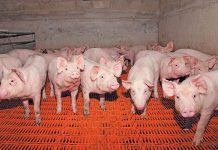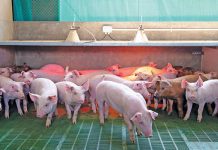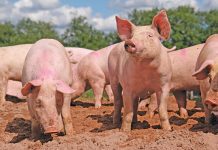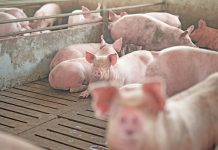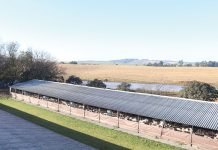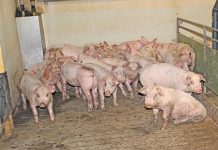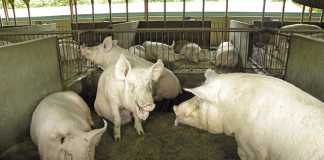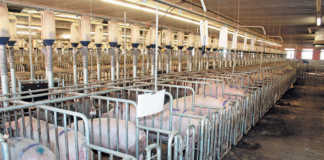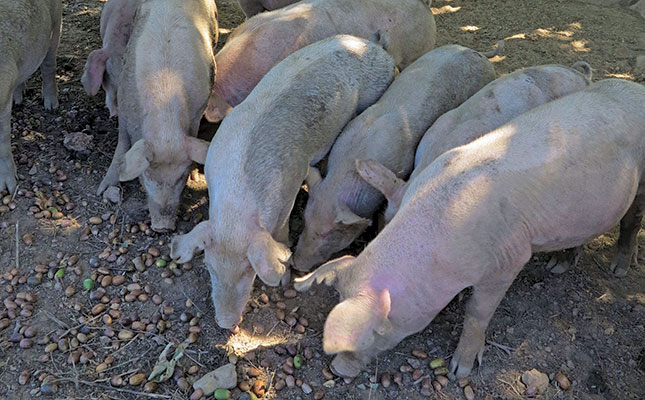
Acorn-fed pigs were first reared on Oak Valley in 1907 by Antonie Viljoen. Now, five generations later, his descendants are doing it again, but on a commercial scale.
The herd remains at a constant 50 sows and a total of 400 pigs, with up to 1 000 porkers produced annually. The pigs take up little space on the estate and roam in eight camps of between 1,5ha and 2ha each, a total of 12ha of this sizable 1 800ha farm.
Oak Valley with more than 4 000 oak trees is a diversified agricultural enterprise that includes fruit, cut flowers, wine and beef. A restaurant, named The Pool Room, serves as a sales platform for the farm-produced produce.
Trial run
Livestock manager Werner Karg has been at Oak Valley for 11 years and conducted trials in 2006 to identify the breed best suited to the area and requirements of Oak Valley. “We knew that Antonie Viljoen had farmed pigs here earlier. His pigs ate the acorns that fell from the trees. He also stored acorns in specially-constructed cement containers and fed them to the pigs throughout the year. So we knew it could work.”
Breeding for quality pork
Werner and his team started by running trials with various breeds and feeding them different feeds to see which combination was best suited to their production system.
“We tried Duroc, Landrace and Big White, feeding them acorns with a mix of Afgri pellets to see what worked best. We concluded that Duroc provided the best marbling but the meat-to-bone ratio was too low. So we crossed Duroc with Landrace to get the ideal balance of marbling and meat-to-bone ratio. Later, we also incorporated Big White into the breeding programme.”
Werner explains that, in addition to pork quality, they also needed to consider the maternal aspects of each breed. “The Duroc’s nursing ability and the amount of milk a sow produces is poor, which is why we also chose the Landrace for its better maternal ability,” he says.
Importance of acorns
Oak Valley’s piggery started production in 2007. “Acorns give pork a unique nutty flavour,” says Werner.
“The acorns are also widely reported to lower bad cholesterol and increase good cholesterol in the pork, and the health benefit is then passed on to the consumer. “But the time of year also affects the taste of the pork. In May and June, when the acorns are fresh, the nutty taste is more pronounced, but it decreases by November when the stored acorns have dried out. So, the fresher the acorns, the greater the impact on the flavour of the pork.”
Staff and school children wanting to earn extra pocket money collect the fallen acorns – between 40t and 50t of them per year – from Oak Valley’s thousands of oak trees. This takes place mainly from February to May.
Then acorns are stored in ventilated bags and kept in a well-ventilated room.
“Air circulation is essential to prevent acorns sweating and eventually rotting,” stresses Werner. “These acorns are fed to the pigs, to supplement those eaten in the free range camps.”
Iberico pigs from Spain traditionally forage for acorns in the oak forests and are then used to produce Bellota ham, a culinary delicacy with a unique taste and health benefits. Werner says that Oak Valley initially considered importing Iberico pigs, but the expense and onerous quarantine requirements made it unviable.
Production
The production process on Oak Valley is stringent and very precise.
“A young sow must weigh 130kg at one year before she is put to the boar.” Pregnancy lasts three months, three weeks and three days – 114 days – during which time she eats 2kg dry sow pellets a day. Four days before farrowing, she is moved into the sow unit, where she stays for five weeks until the piglets are weaned.
While suckling her piglets, she receives 2,5kg lactating sow pellets a day plus 500g for every piglet she is feeding. The sow unit is under roof, but open-sided in summer to maintain a minimum temperature of 26°C.
At night, the sides are closed to retain warmth, with heating lamps coming on automatically if the temperature drops below 26°C. At five weeks, piglets are moved to the weaner house for eight weeks before being moved to large outdoor camps to roam free-range for four to five months.
During this time they eat acorns at will, but receive additional acorns for the last three months before going for slaughter. A sow comes on heat again four to five days after piglets are weaned, so she is returned to the dry sow camp where a boar will service her. “We do pregnancy tests after six weeks,” says Werner. “If pregnant, she stays in the camp until a week before she farrows.”
Acquiring a pregnancy test instrument, which confirms pregnancy after six weeks, has been a big cost saving, he says.
“It saves a lot on feed as we don’t waste any on unproductive sows. If a sow doesn’t conceive the first time, she’ll come on heat again three weeks later. If she doesn’t conceive then, we cull her to avoid unnecessary feeding.” Oak Valley does no artificial insemination as the piggery is relatively small. But it remains an option for the future.
Acorn feeding
Oak Valley’s pigs also eat acorns when grazing in the camps. “But acorns have relatively low nutritional value, with a protein content of only about 6%,” explains Werner.
“So we also supplement the pigs’ diet by feeding them pellets to ensure their growth. These contain 16% protein and each pig gets 1kg daily.” The pigs are fed acorns from four months, and for their remaining three months on the farm, until they are slaughtered at a weight of 75kg.
Oak Valley’s piggery is state-of-the-art and eco-friendly. Automatic feeders enable pigs to eat dry pellets, or to mix them with water according to preference. Water nipples provide constant drinking water.
In the sow house, pigs stand on plastic mesh floors that allow waste to drop through the mesh openings to a lower level from where it is flushed out and piped onto the sorghum lands. Sorghum is in turn harvested and fed to the cattle on the estate. One permanent employee runs the entire piggery under Werner’s guidance.
“We deworm sows twice a year and deworm piglets before they go out to the camps,” explains Werner. He injects pregnant sows with Circoflex to increase protein absorption and with FarrowSure Gold against viral and bacterial diseases.
Piglets receive iron injections two or three days after birth but before they leave the sow house as they are not yet burrowing in the sand where they would normally absorb iron. Elgin Valley soil’s has a high iron content.
“We use no antibiotics unless the vet advises us to do so for a specific purpose, and we never administer growth hormones,” Werner stresses.
Production costs
He confirms that costs double when raising free-range, acorn-fed pigs. “This is because they expend much energy walking around, which would normally be conserved and go into putting on body weight if they were housed and inactive. The more exercise a pig gets, the better the marbling of the pork but growing too fast can deplete the marbling. So we maintain the correct balance.”
Based on a litter of eight piglets, it cost about R260 per piglet to feed a sow until farrowing. Farrowing in a sow unit reduces the likelihood of a sow crushing her piglets. Oak Valley sows farrow on average 2,2 times annually and litters average 10 piglets in size.
Oak Valley is currently attaining free range certification through the SA Meat Industry Company. About 20 pigs are marketed a week to select butcheries in the Western Cape, and the restaurant on the farm.
Profiting
Currently, the pig manure only fertilises the sorghum for the cattle herd on Oak Valley.
“Eventually, we want to generate power from the methane gas produced from dung, but we’re not big enough for that yet,” says Werner.
“Most important, is that our management has to be good to make a profit. We never skimp on food so we have good production. If the sow doesn’t get enough protein she’ll reabsorb embryos to meet her protein needs. Our production is higher than the average, because the protein balance in the food is correct.”
Visit www.oakvalley.co.za or email [email protected].

